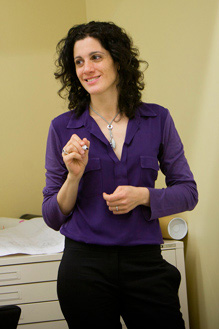RESEARCH SPOTLIGHT
Sesquicentennial fellow co-runs new Landscapes and Objects Lab
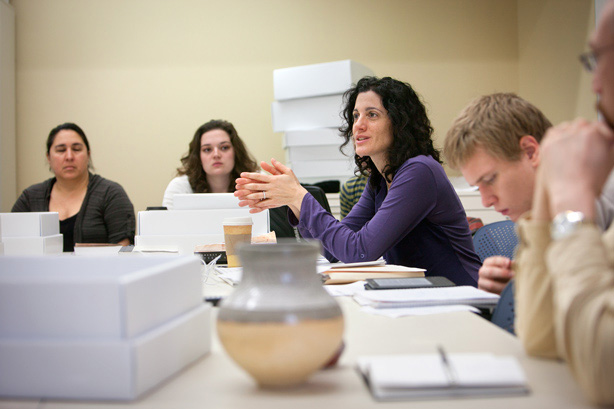
Lori Khatchadourian, an assistant professor of Near Eastern studies and a Sesquicentennial Faculty Fellow, with students in the new Landscapes and Objects Laboratory in McGraw Hall.
When Lori Khatchadourian completed a Hirsch Postdoctoral Fellowship at Cornell, her teaching and research so impressed the chairs of the anthropology, history, Near Eastern studies and classics departments that they told the deans to do everything they could not to lose her when the fellowship ended.
And thanks to a Sesquicentennial Faculty Fellowship contributed by Howard Milstein '73, Khatchadourian is now an assistant professor of Near Eastern studies.
"We are delighted that Lori has joined the ranks of Milstein fellows, especially given my passion for archaeology and history," says Milstein. "When Abby and I had dinner with Lori and her husband in Barton Hall recently, it became clear why she was such an important addition to the department."
Kim Haines-Eitzen, chair of Near Eastern studies, says the department is enormously grateful for Milstein's generosity. "Lori is a dynamic and exciting scholar," she says, noting that the "stars aligned" when the anthropology department was able to hire Khatchadourian's husband, Adam T. Smith, an esteemed scholar. The two will share a new archaeology lab in McGraw Hall (see sidebar) that will focus on sophisticated spatial and material analysis of artifacts.
"One of the things I find most exciting about Lori's work is her ability to think about artifacts and things in as dynamic a way as we think about texts," says Haines-Eitzen. "She's really at the cutting edge, bringing sophisticated theoretical approaches to archaeology. She has also been a huge hit with both undergraduate and graduate students, who have raved about her courses."
Traditionally archaeologists study only the deep past, but Khatchadourian thinks about empires from the modern to the ancient. Looking at the genealogies of empires, says Khatchadourian, "helps us understand our contemporary condition as either subjects of or agents of empire. Some very old approaches to imperialism are still in the repertoire of politics today. The methods and theories of archaeology can offer unique insights into empires both ancient and modern."
She also points to the ways in which modern states turn to the archaeological past as grist for contemporary political aspirations, or as a reservoir of symbols that can be harnessed to help forge collective senses of identity, such as what happens in countries of the Middle East and former Soviet republics that are the focus of her work.
Khatchadourian currently co-directs archaeological fieldwork at a site in central Armenia called Tsaghkahovit, which was a part of the Persian Empire of the sixth through fourth centuries B.C., but she soon plans to turn to the archaeology of the Russian Empire and Soviet Union.
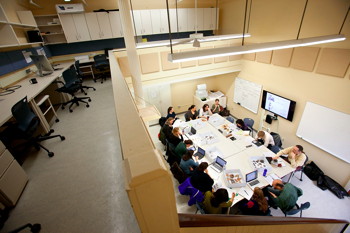
Detail of the new Landscapes and Objects Laboratory in McGraw Hall. The lab is located on two levels in what used to be the McGraw Hall Museum and is serving as a hub for archaeological conversation across the university. See larger image
Right now, Khatchadourian is engaged in the study of imperialism's conquered communities. She's interested in how these communities are subjugated by the forces of empire, as well as how they in turn reshape imperial projects.
"Through direct and indirect processes, imperial authorities sometimes modify their own worldviews to accommodate the views of the diverse communities they conquer. This seems to come with the territory of any kind of expansionary project."
Linda B. Glaser is staff writer for the College of Arts and Sciences.
New lab is hub of activity on two levels in McGraw Hall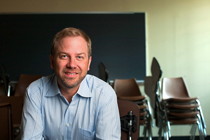 Adam T. Smith, professor of anthropology. See larger image The new Landscapes and Objects Laboratory in McGraw Hall, built for Near Eastern studies assistant professor Lori Khatchadourian and anthropology professor Adam T. Smith, is serving as a hub for archaeological conversation across the university. The lab builds on Cornell's strengths in archaeology and offers a new resource for the interdisciplinary work of archaeology, which bridges the social, humanistic and natural sciences. "One of the reasons that Cornell was so attractive to us is because there are so many archaeologists in different departments," says Khatchadourian. Students and faculty in all these departments now have a new space to conduct and share research and build a sense of esprit de corps, she says. The lab will enable graduate students and advanced undergraduate archaeology majors to learn techniques of spatial and material analysis, such as GIS and X-ray fluorescence, a powerful tool for characterizing the chemical composition of artifacts. The lab is located in the former McGraw Hall Museum and features a mezzanine level for individual workstations. The main level is used for teaching, seminars and workshops, and includes space for sorely needed artifact storage. "The lab has already become an active research and teaching space. Graduate students are hard at work upstairs while an advanced seminar class is under way. It's an exciting time for archaeology at Cornell," Khatchadourian says.
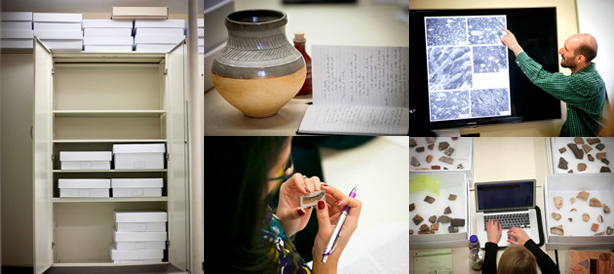 Detail of the new Landscapes and Objects Laboratory in McGraw Hall. The lab is located on two levels in what used to be the McGraw Hall Museum and is serving as a hub for archaeological conversation across the university. See larger image |
